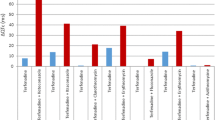Abstract
Several drugs used in clinical practice can influence the ECG behaviour. It is very important for the clinician to know the most common ECG alterations due to drug administration.
Starting from three clinical cases, this chapter discusses about drugs inducing ECG modifications. In each case there is an accurate ECG analysis, the way to get to the correct diagnosis and a theoretical description of the possible mechanisms.
The first case deals with QT prolongation due to psychotropic drugs, the second case is about IC antiarrhythmic drugs effect, and the last case shows the ECG modifications due to digoxin.
In the last part of the chapter there is an overview about the common used drugs and their mechanisms and correlate ECG modifications.
Access this chapter
Tax calculation will be finalised at checkout
Purchases are for personal use only
Similar content being viewed by others
References
van Noord C, Eijgelsheim M, Stricker BHC. Drug- and non-drug-associated QT interval prolongation. Br J Clin. 2010;70(1):16–23.
Newton-Cheh C, Eijgelsheim M, Rice KM, et al. Common variants at ten loci influence QT interval duration in the QTGEN Study. Nat Genet. 2009;41(4):399–406.
Arking DE, Pfeufer A, Post W, et al. A common genetic variant in the NOS1 regulator NOS1AP modulates cardiac repolarization. Nat Genet. 2006;38(6):644–51.
Surawicz B, Knilans T. Chou’s electrocardiography in clinical practice. 6th ed. Philadelphia: Saunders Elsevier; 2008.
Oreto G. Elettrocardiogramma: un mosaico a 12 tessere. 1st ed. Torino: Centro scientifico editore Edi-Ermes; 2009.
Funck-Brentano C, Jaillon P. Rate-corrected QT interval: techniques and limitations. Am J Cardiol. 1993;72(6):17B–22B.
Locati ET, Bagliani G, Padeletti L. Normal ventricular repolarization and QT interval. Card Electrophysiol Clin. 2017;9(3):487–513.
Glassman AH, Bigger JT. Antipsychotic drugs: prolonged QTc interval, torsade de pointes, and sudden death. Am J Psychiatry. 2001;158(11):1774–82.
AIFA. Cardiotossicità dell’aloperidolo. Le basi scientifiche delle disposizioni regolatorie. Farmacovigilanza. 2007.
Drolet B, Rousseau G, Daleau P, et al. Pimozide (Orap®) prolongs cardiac repolarization by blocking the rapid component of the delayed rectifier potassium current in native cardiac myocytes. J Cardiovasc Pharmacol Ther. 2001;6(3):255–60.
Woosley RL, Heise CW, Romero K. CredibleMeds.org: what does it offer? Trends Cardiovasc Med. 2017;17:30114–7.
Crijns HJ, Van Gelder IC, Lie KI. Supraventricular tachycardia mimicking ventricular tachycardia during flecainide treatment. Am J Cardiol. 1988;62:1303–6.
Nabar A, Rodriguez LM, Timmermans C, Smeets JL, Wellens HJ. Radiofrequency ablation of “class IC atrial flutter” in patients with resistant atrial fibrillation. Am J Cardiol. 1999;83:785–7.
Falk RH. Proarrhythmia in patients treated for atrial fibrillation or flutter. Ann Intern Med. 1992;117:141–50.
McNamara RL, Tamariz LJ, Segal JB, Bass EB. Management of atrial fibrillation: review of the evidence for the role of pharmacologic therapy, electrical cardioversion, and echocardiography. Ann Intern Med. 2003;139:1018–33.
Crijns HJGM. Clinical manifestations of use- and reverse-use dependence. In: Crijns HJGM, editor. Changes of intracardiac conduction induced by antiarrhythmic drugs: importance of use- and reverse use-dependence. Groningen: Knoop; 1993. p. 38–105.
Wiesfelda ACP, Ansinkb JM, van Veldhuisena DJ, van Gelde IC. Broad complex tachycardia during treatment of atrial fibrillation with a 1c antiarrhythmic drug: ventricular or supraventricular proarrhythmia? Int J Cardiol. 2006;107:140–1.
Echt DS, Liebson PR, Mitchell LB, et al. Mortality and morbidity in patients receiving encainide, flecainide, or placebo. The cardiac arrhythmia suppression trial. N Engl J Med. 1991;324:781–8.
De Paola AA, Horowitz LN, Morganroth J, et al. Influence of left ventricular dysfunction on flecainide therapy. J Am Coll Cardiol. 1987;9:163–8.
Anno T, Hondeghem LM. Interactions of flecainide with guinea pig cardiac sodium channels. Importance of activation unblocking to the voltage dependence of recovery. Circ Res. 1990;66:789–803.
Hilliard FA, Steele DS, Laver D, et al. Flecainide inhibits arrhythmogenic Ca2+ waves by open state block of ryanodine receptor Ca2+ release channels and reduction of Ca2+ spark mass. J Mol Cell Cardiol. 2010;48:293–301.
Zipes DP, Libby P, Bonow RO, Braunwald E. Braunwald’s heart disease: a textbook of cardiovascular medicine. 10th ed. Oxford: Elsevier; 2014.
Holstege CP, Eldridge DL, Rowden AK. ECG manifestations: the poisoned patient. Emerg Med Clin North Am. 2006;24(1):159–77.
Hohnloser SH, Halperin JL, Camm AJ, et al. Behalf of the PALLAS Investigators interaction between digoxin and dronedarone in the PALLAS trial. Circ Arrhythm Electrophysiol. 2014;7:1019–25.
Author information
Authors and Affiliations
Editor information
Editors and Affiliations
Rights and permissions
Copyright information
© 2019 Springer Nature Switzerland AG
About this chapter
Cite this chapter
Bonelli, P., Giannini, I., Matassini, M.V., Menditto, A. (2019). Drug Effects on ECGs. In: Capucci, A. (eds) New Concepts in ECG Interpretation. Springer, Cham. https://doi.org/10.1007/978-3-319-91677-4_13
Download citation
DOI: https://doi.org/10.1007/978-3-319-91677-4_13
Published:
Publisher Name: Springer, Cham
Print ISBN: 978-3-319-91676-7
Online ISBN: 978-3-319-91677-4
eBook Packages: MedicineMedicine (R0)




